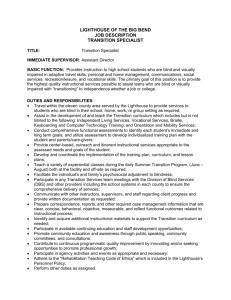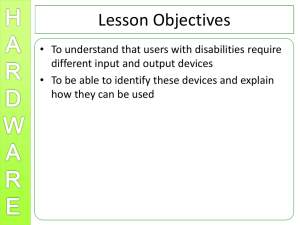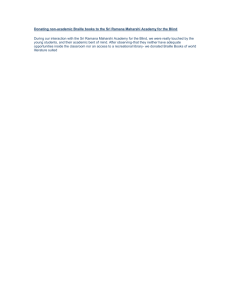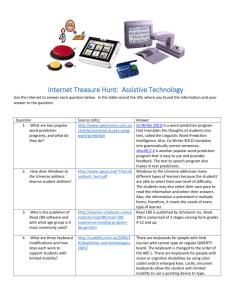Teaching the Teachers Braille: Building Equality in Literacy towards
advertisement
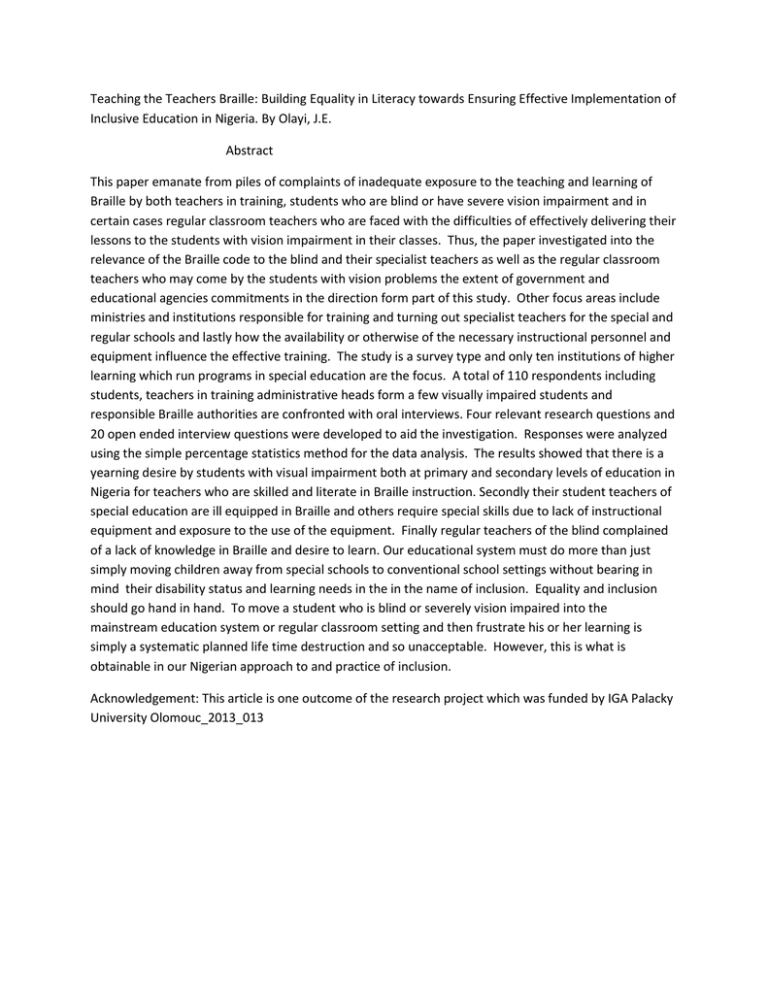
Teaching the Teachers Braille: Building Equality in Literacy towards Ensuring Effective Implementation of Inclusive Education in Nigeria. By Olayi, J.E. Abstract This paper emanate from piles of complaints of inadequate exposure to the teaching and learning of Braille by both teachers in training, students who are blind or have severe vision impairment and in certain cases regular classroom teachers who are faced with the difficulties of effectively delivering their lessons to the students with vision impairment in their classes. Thus, the paper investigated into the relevance of the Braille code to the blind and their specialist teachers as well as the regular classroom teachers who may come by the students with vision problems the extent of government and educational agencies commitments in the direction form part of this study. Other focus areas include ministries and institutions responsible for training and turning out specialist teachers for the special and regular schools and lastly how the availability or otherwise of the necessary instructional personnel and equipment influence the effective training. The study is a survey type and only ten institutions of higher learning which run programs in special education are the focus. A total of 110 respondents including students, teachers in training administrative heads form a few visually impaired students and responsible Braille authorities are confronted with oral interviews. Four relevant research questions and 20 open ended interview questions were developed to aid the investigation. Responses were analyzed using the simple percentage statistics method for the data analysis. The results showed that there is a yearning desire by students with visual impairment both at primary and secondary levels of education in Nigeria for teachers who are skilled and literate in Braille instruction. Secondly their student teachers of special education are ill equipped in Braille and others require special skills due to lack of instructional equipment and exposure to the use of the equipment. Finally regular teachers of the blind complained of a lack of knowledge in Braille and desire to learn. Our educational system must do more than just simply moving children away from special schools to conventional school settings without bearing in mind their disability status and learning needs in the in the name of inclusion. Equality and inclusion should go hand in hand. To move a student who is blind or severely vision impaired into the mainstream education system or regular classroom setting and then frustrate his or her learning is simply a systematic planned life time destruction and so unacceptable. However, this is what is obtainable in our Nigerian approach to and practice of inclusion. Acknowledgement: This article is one outcome of the research project which was funded by IGA Palacky University Olomouc_2013_013 Introduction: Reading and writing is not a privilege, rather it is a right. All blind and visually impaired Nigerian children would have equal access to their particular tools of literacy so that they can thrive and be safeguarded against the pipelines to poverty and social imprisonment generally associated with illiteracies. Unfortunately, in Nigeria, these measures of safety are all too often missing for children with disabilities, including children who are blind or severely vision impaired. Reviewing the Australia situation, Power, (2005) noted that since the 1970’s, students who are blind or severely vision impaired have been integrated from specialist schools to the mainstream of Australian education system. This also, has been stressed by Gale, (2001 p25) these writers observed that among other benefits of inclusion is increase tolerance and acceptance of students who are blind and vision impaired in the community. Paradoxically however, in Nigeria, the attempts to create inclusive education system over the years tend to rather exclude students who are blind or severely vision impaired from reaching the literacy levels of their peers. This unpleasant situation is not unconnected with lapses inadequate preparation of teachers of the visually impaired in Braille skills amongst other special skills required in readiness for teaching and instructing the blind and vision impaired children especially in a regular classroom. Other factors include shortage of manpower in the areas of needs in our institutions of higher learning responsible for training and turning out teachers for our regular primary and secondary schools. Worthy of mention too is the absence of the necessary teaching aids required for practical teaching and learning including slates and stylus, Braille machines, Braille papers, and of course the most recent high tech Braille devices and equipment for Braille instructions. This paper examined the various factors influencing the poor quality of the knowledge of Braille reading and writing among teachers of the visually impaired especially those meant for development into the regular classrooms for inclusive educational. Prominent in this enquiry was in the desire to understand how much of the instructions in Braille are being taught to future teachers of the blind and visually impaired in the various units and departments of special education in the Universities, Colleges of education and Polytechniques in Nigeria. Another very important focus of this paper was the issues concerning availability of equipment for teaching and instructing teachers in training on effective Braille writing and reading skills. Statement of the problem: Personal preparation remains a critical factor which stakeholders of the Universal Basic Education program in Nigeria must pay adequate attention too if inclusive education for children who are blind or severely vision impaired is to be realized. Teachers of the blind and visually impaired must be properly equipped with braille reading and writing, mobility training and instruction, as well as the use of typewriting and computer skills. This is the only sure way for effective inclusion of the blind children into the regular classroom under the current UBE system in Nigeria. The purpose of this study is based on the findings of previous research on the inadequacies of our Institutions of higher learning responsible for preparing teachers of the visually impaired for our regular schools under the USB education system. The study also presents major problems hindering the effective application and utilization of the Braille code system of reading and writing by the blind and vision impaired and preferred necessary solutions. With a view to enhance successful inclusive practices for our children who are blind and severely vision impaired. This study is significant in several ways. Foremost is the enlightenment it would provide to German reading population hence its translation into the German language. To the other world, it represented a picture of the problems faced by the blind and visually impaired in Nigeria regards to their only medium of literacy. Most importantly, the study would provide an understanding of the usefulness of the Braille code to the blind including those who are severely vision impaired. It explained the need for proper and adequate preparation of those to handle the teaching and instructional activities for the blind in the regular classroom within an inclusive setting. To provide a guide to this study, four relevant research questions are put forward to guide the review of opinions of other authorities in this field. They include: 1. What is Braille, of what relevance is the Braille code to the blind and vision impaired? 2. To what extent have the government and other agencies and institutions been committed to the training, production, procurement, and deployment and/or supply of the blind and visually impaired across the Nigerian nation? 3. Whose responsibility is it to provide adequate training for the required teachers and instructors of the blind and visually impaired in Nigeria. 4. To what extent has availability or otherwise of the necessary instructional aids, ill equipped personnel or short supply of instructors affected the effective training of the personnel for inclusive program under the UBE system in Nigeria. The method employed in this study is the survey approach. This design provided the researcher the ample opportunity of involving sufficient stakeholders in the education and training of persons living with disabilities including the blind and visually impaired in the study. Participants in the study were drawn from the 10 Federal Government Institutions of higher learning offering courses in special education and charged with the responsibilities of admitting, training, and turning out of graduates of special education as teachers and service providers in other areas for all categories of persons living with disabilities in Nigeria. These institutions included The University of Jos, University of Ibadan, University of Calabar, University of Ilorin, University of Nigeria Nsuka, University of Ifa, University of Maidugri, Bayere University Kano, Federal College of special education Oyo, Federal College of education, Panshin and the Kaduna Kaduna Polythenic Kaduna. To guarantee equal opportunity of participation among students of these institutions, a simple sampling technique for selection of participants was adopted. A total number of students enrolled for special education program in each of the institutions were obtained by the researcher for the 2013-2014 academic year. Ten participants from each of the ten institutions were selected using a secret ballot of yes to participate and no for abstaining. A hundred students including the sighted and visually impaired were used for the study. An open ended questionnaire was designed and administered in the respondents on issues bothering the problem under investigation. For ease of understanding and analyses, a simple percentage statistical method of analysis was used to interpret the information gathered. As a matter of fact, the researcher deliberately made use of all heads of units and departments of special education in the various institutions to authenticate information on item 2 of the specific research question bothering on Government commitments to the course of the special teachers training programs of their institutions. Myriads of scholarly works in the field of education and rehabilitation of the blind and visually impaired have come to accept that Braille is essential for an effective literacy program of any given blind or vision impaired child. According to Gale, (2001) and Mattiazzo, (2005) in their review of the Australian integration program for the blind and vision impaired students in regular schools, argued that Braille is the most important literacy tool for early childhood students who are blind or severely vision impaired. They contend that those who do not have access to sound Braille reading and writing skills had greater chances of becoming illiterate in later life. Commenting on the negative effects of inadequate Braille instruction for students, who are blind or have very low vision, the advocacy officer for blind citizens Australia, The National Peak advocacy organization for people who are blind or vision impaired observed that such students simply miss out similarly, The National Braille Council of Nigeria (NABRACON) over the years had maintained that blind or vision impaired who rely on audio speech as their main means of reading, miss out on the constant reinforcement of spellings, grammar, and syntax which can only be by reading with the eyes or fingers. In a review of ten years of continued evaluation of results of candidates who are blind or severely vision impaired taking the West African Examination Certificate (WAEC) on English NABRACON concluded that the poor performance in the English language as well as wrong spellings noted in other subjects is as a result of inadequate Braille reading instruction at the primary and secondary school levels. According to Obi, (2012) most individuals with little access to Braille literacy skills would freely admit in their adult life that they merely struggled with basic literacy skills. In this same vain, Abosi and Ozoji, (1985) stated that Braille is a major and the most important means of communication for those who are blind or partially sighted. They further noted that in most cases, even those who can manage to read large print still prefer Braille because according to them, faculties for large print are almost nonexistent in Nigerian schools. Braille is adaptable for use in reading writing, math, music, foreign language, and science. On her part, Okeke, (2001) asserts that education is essential for the visually handicapped. This is because to her “A person who cannot read or write is likely to develop a sense of inadequacy and inferiority, which is psychologically damaging.” She identified Braille as an essential need in the education of the blind or visually impaired. Citing Heward and Orlanskay (1980) Okeke upheld the view that the teacher should obtain and prepare specialized materials as well as put reading assignments in to Braille format. Generally speaking, inclusive education in Nigeria has far reaching implications for personnel preparation, pedagogy, curriculum, learning environment, funding, conditions of service, school management structures, monitoring, and evaluation. (Nwazuoke) If the goals of inclusive education are to be achieved, planners of the UBE must pay adequate attention to the area concerned with personnel preparation for it is a very critical factor. Capacity building in support of inclusive education for all categories of those living with disabilities should, apart from training of graduate specialties in managing our special needs children, but also involve the training of the regular classroom teachers to be able to respond appropriately to the challenges posed by the children in their classrooms. This calls for government serious commitment in the area of training and turning out teachers who can read and write Braille, provide instructions on independent living including mobility and orientation as well as other daily living skills required for the blind and visually impaired. As government commitment, the Nigerian Disability Decree, 1993, section 5 (Now Act) states (inter alia), that among others “Government organs and authorities shall ensure adequate training for personnel to cater for the educational development of the disabled in educational institutions”. As a sign of government commitment to encourage the training of personnel to teach and manage children with disabilities in general and the blind and vision impaired in particular. Abosi and Ozoji (1985) reported that the Federal Government introduced and floated a special bursary for all wishing to take courses leading to work and care for those living with disabilities. Also, an element of special education across our higher institutions as a way of creating awareness and inculcating knowledge about the educating of special needs children in all would be teachers in Nigeria. It is important to state that it is a demonstration of government commitment that lead to the establishment of Federal College of Special Education Oyo to specifically cater for the various categories of children living with disabilities in our Special and regular schools. This noble gesture was greatly enhanced by Kaduna Polytechnic and a handful of Federal Universities by floating full fledge departments offering Special Education programs or as units within vocational education departs for turning out teachers and instructors for the blind and other categories of disabled individuals in schools. Ayoku, (2006) observed that Braille gives the blind child greater and better access to the school curriculum. According to him, Braille enables the child to participate effectively in lessons in the various subjects including reading, dictation, Social studies, sciences, Mathematics, and languages with the use of the appropriate codes for these subjects. About who trains the teachers for the blind and vision impaired to be specific and the Special needs children in general, The Blue Print on the Education, (2004), clearly places the responsibility on the various Institutions and faculties of Education offering Special Education programs to ensure the production of quality teachers for all categories of special needs children in our schools. Considering the enormous task placed on our Institutions to in ensure adequate training and turning out of teachers of the visually impaired and others, there is the need for adequate provision of the necessary teaching aids. Is the materials and equipment required for drilling of these personnel who are to go out and teach our children with visual impairment in the regular schools? A renowned Scholar and an icon of Special Needs Education in Nigeria, Professor I.A. Nwazuoke, recently in his Inaugural lecture at the University of Ibadan, Nigeria, wondered if inclusive education will really thrive in Nigeria. According to him inclusive education cannot succeed under the circumstance with poor infrastructural facilities, poor funding for special needs education, inadequate preparation of personnel for the program, including the absence of the necessary training equipment for our teachers in training in our various institutions offering courses in special education. Others are the absence of vital technological devices in our schools as well as the nonavailability of scholarships for our special needs persons and those willing to work with them as an inducement to enroll for the program. In spite of the beauty of the various policies and statements made towards providing suitable and functional educational services to persons living with disabilities in Nigeria. The absence of binding legislations to back up these policies made implementation difficult, half hazard in some places, and totally a failure in other areas. It is worthy of note to mention here that while many countries of the world try to provide education for their citizens using guidelines codified as Ordinances, Acts of Parliament, Circulars, and commissioned reports. This is not yet practicable in Nigeria. This lack of backing up policies with legislations has indeed remained a mountain of problems to both practitioners and the beneficiaries. Hence, one can hardly find where to table his or her complaints resulting from poor or outright inadequate attention to services already stated in the policy including the blue print regarding education of the handicapped in Nigeria. Discussion of findings From the results obtained from the respondents across the 10 institutions in Nigeria, student teachers in training across the institutions show enthusiasm in the learning of Braille and other special skills use for teaching the blind and the deaf. They accepted that the relevance of Braille to a visually impaired child remain paramount to the child literacy program. 90 of the 100 students responded in favor of the relevance of Braille in the literacy program of the visually impaired. 5% representing show apathy arguing that the audio method is preferable. 3% were of the opinion that print medium should be used side by side with Braille. While 2% of the respondents were neither for braille, audio, or print indicating lack of knowledge of the subject matter. This however, is in agreement with Gale (2001), Mattiazzo (2005), Obi (2012), Nwazuoke (2010), and Abosi and Ozoji (1995), whose opinions are that Braille remains the most important tool for any literacy program especially at the primary and secondary levels of education for the visually impaired children On the question of extent of Government Commitment, respondents to this find it difficult to share clearly their opinions, especially among students. However 60% were of the view that the government is doing a lot but have not demonstrated serious commitment in the areas of recruitment, deployment, and remuneration of specialist teachers. Ten administrative heads who responded to questions related to this idea argued that poor funding and lack of enforcements of trainers on the part of government as well as inadequate supply of modern instrumental aids for the blind and other special needs categories have hindered effective realization of the goals set in the curriculum for their student teachers in training. This is seriously upheld by Nwazuoke (2010), when he argued that unless state holders in the educational sector take serious steps to correct the anomalies resulting from poor funding, shortage of specialist teachers, and absence of incentives to those already in the field. Inclusion of the blind and other special needs children will remain elusive and crumble unless the current Universal Basic Education (UBE) system, a replica of the former Universal Primary Education program (UPE) 1977 in Nigeria. On the issue of whose responsibility it is to train teachers of the visually impaired and other special needs categories, respondents noted with great concern that of education that is the universities, colleges of education, and polytechnics offering special education program in the various special needs areas. These views are highly upheld by Okeke (2001), Federal Government of Nigeria NPE 2004, 2007, and the Blue Print on the education of the handicapped 1992, where specific responsibilities were assigned to these institutions with regards to production and turning out of specialist manpower skilled in managing and instructing pupils with special needs in our special and regular schools. However both all students in training, blind and visually impaired students, management staff and the institutions concerned as well as the Braille authorities in Nigeria [National Braille Council of Nigeria (NIBRACON)] agreed to the fact that Braille is insufficiently promoted among the teachers of the visually impaired students whose primary tool for any literacy program is Braille, respondents agreed that instructional aids like Braille machines, slates and stylus, and other traditional low tech equipment are insufficiently available across theboard for effective teacher preparation. And the very few available ones lack maintenance and out of use. They generally agreed to the fact that high tech equipment like computers and software including screen readers of various types are not available for any teaching of practical demonstration for teachers mastery. Conclusion, As it stands, the Government of Nigeria and indeed all stakeholders in the education sector must look beyond universalizing access to improving teaching and learning conditions to make any headway in the implementation of the Universal Basic Education (U.B.E.) program. It is important to ask here the benefits of the blind or severely vision impaired child if he or she finds himself or herself in a learning environment where prior provisions has not been made for his learning needs particularly where there is no Braille literacy instructor to help him or her acquire the necessary literacy skills in Braille. For inclusive practice to succeed within framework of U.B.E. system in Nigeria, especially for the visually impaired instructional procedures, importantly Braille literacy, for both the teachers and learners must be vigorously enhanced. Again learning experience, instructional facilities and utilities, and the use of technology must be strictly geared towards meeting the learning needs of all children whether special needs or not. We should all bear in mind that, an inconclusive education system can impede the chance of all children to have equal rights to literacy. References: Abosi, O.C. & Ozoji, E.D. (2005), Educating the blind (A descriptive Approach) Ibadan: Spectrum Books Ltd. Ayoku, F.A. (2006), the visually impaired in the regular classroom. In T.C. Obani (ed) Teaching pupils with special educational needs in the regular classroom. Ibadan: Book Builders Editions Africa. Federal Government of Nigeria (1992), Blue print on the education of the handicapped. Lagos: Federal Ministry of Education. Federal Government of Nigeria (2004), National Policy on Education. Lagos: NERDC Gale, G.(2001), In Australia, Braille literacy matter: the educator. 13 (1) pp13-20 Hehir, T. (2002), Encouraging Braille literacy among teachers of the visually impaired (TVI) in education. Harvard educational review. 72 pp 1-32 Nwazuoke, I.A. (2010), Paradigms, perspectives and issues in special needs education. An inaugural lecture University of Ibadan. University of Ibadan press. Obi, J. (2012), why teachers of the visually impaired should acquired Braille skills. News letter. Lagos: National Braille Council of Nigeria. Okeke, B. (2001), Essentials of special education. Nsukka: Afro-Orbis publications Ltd. Power, J. (2005), Interview with Aileen Mcfadzean. National advocacy officer blind citizens. Australia. The national inquiry into teaching of Braille literacy (2005). Accessed online 7 (2). Retrieved 9th April, 2014. http://www.accessonline

